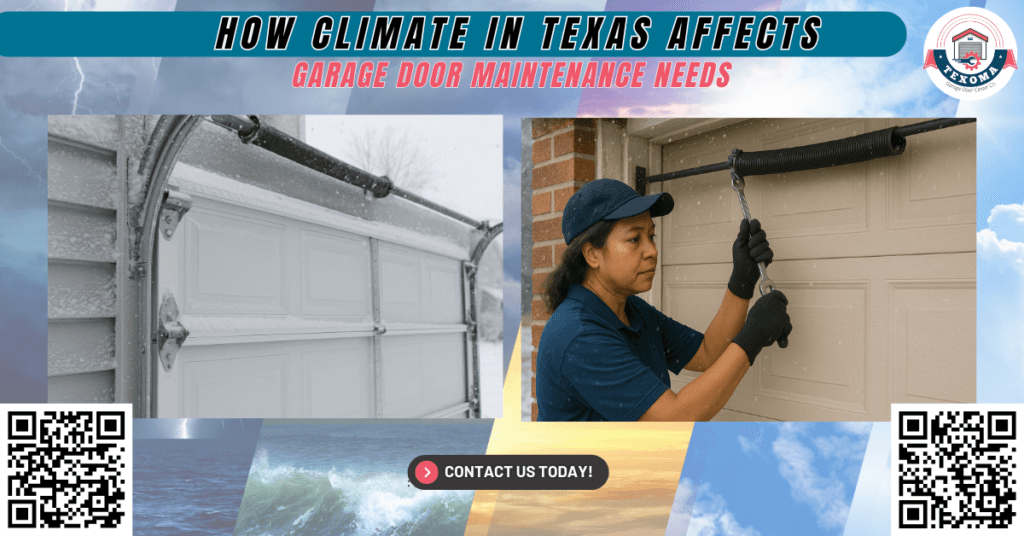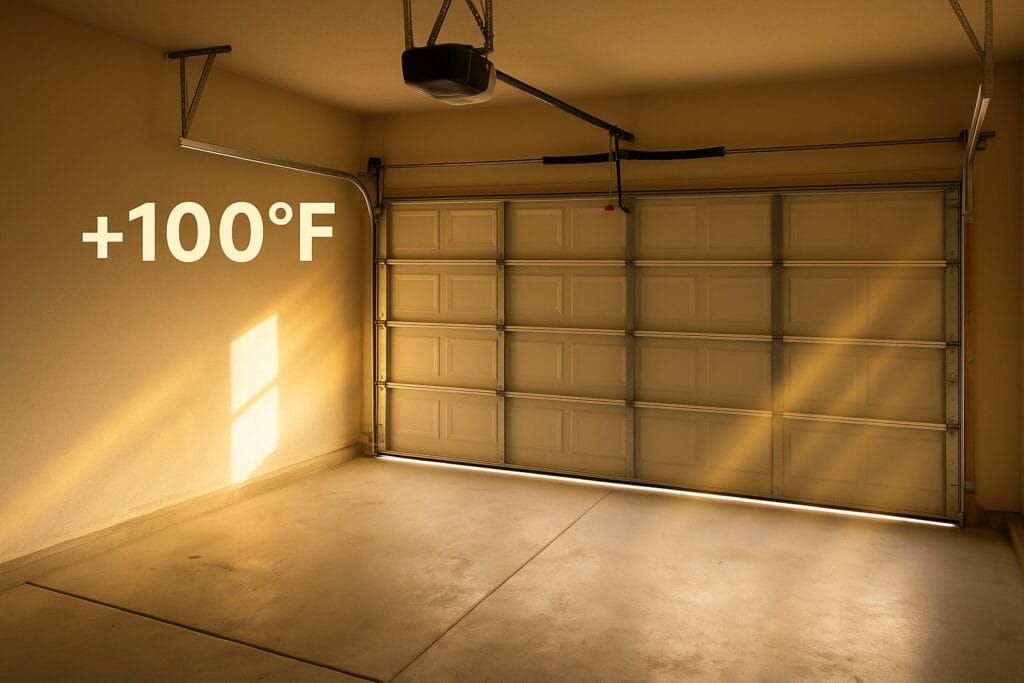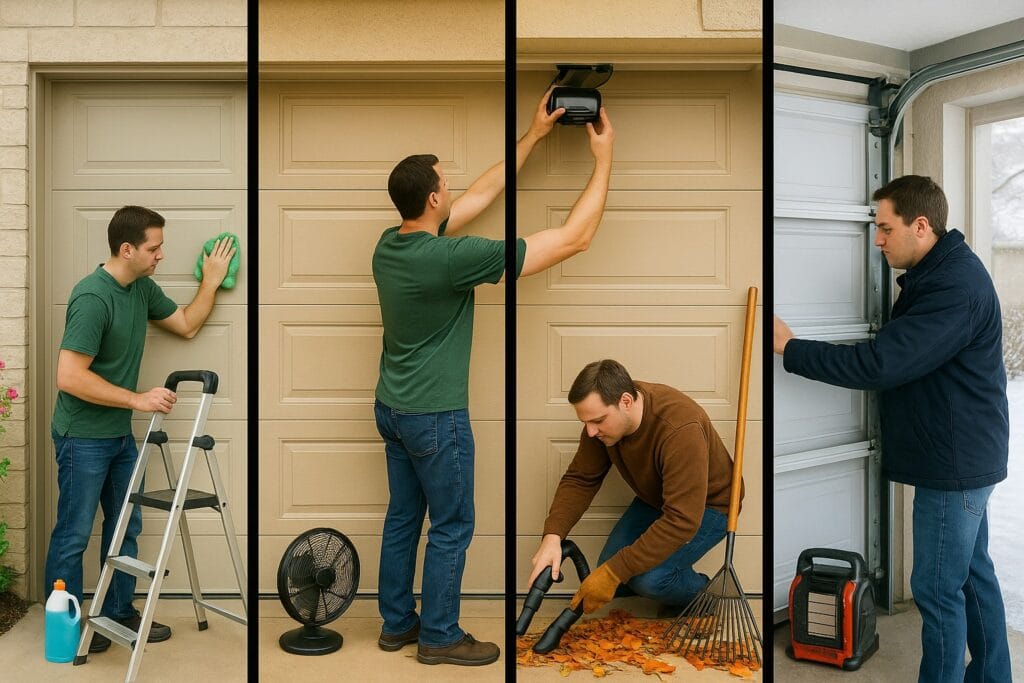How the Climate in Texas Affects Garage Door Maintenance Needs

A few months ago, in Sherman, TX, a local family called us when their garage door jammed during a 105°F heatwave. The issue? The metal parts had expanded in the extreme heat, causing the rollers to seize up and the automatic opener to strain and eventually fail. It wasn’t just inconvenient; the family was locked out of their garage with no access to tools, bikes, or their washer and dryer. Situations like this are increasingly common in Texas due to the state’s unpredictable and extreme weather patterns.
According to the Texas State Climatologist, severe weather events are becoming more frequent and intense. From long-lasting heat waves and powerful storms to freezing winter blasts, Texas weather can cause serious wear and tear on garage doors. That means homeowners and businesses must stay ahead of the game with proper garage door maintenance to avoid costly repairs or safety risks.
The first step to avoiding these issues is understanding how the climate in Texas affects your garage door system. From springs and cables to the opener and sensors, every component plays a role in the smooth operation of your garage door. In this comprehensive guide, we’ll explore how each season impacts your garage door and offer year-round tips to ensure optimal performance and safety.
Why Texas Weather is Tough on Garage Doors
Extreme Heat and Sun Exposure
Summers in Texas can be brutal, with many regions regularly experiencing temperatures well above 100°F. These scorching conditions can wreak havoc on your garage door system. The metal parts, such as torsion springs, hinges, tracks, and garage door rollers, expand in high temperatures, which can misalign the door and strain the garage door opener. This reduces the system’s lifespan and often leads to the need for premature repairs or replacements.

Prolonged sun exposure can also fade or peel the finish on steel or wood doors. For wood doors, the risk of warping or cracking increases due to uneven heating and moisture loss. Rubber weatherstripping and seals can become brittle and crack, leading to poor insulation and higher energy bills. Regular maintenance tasks like cleaning panels, inspecting the sealant, and applying UV-resistant paint or finish can help protect your garage door from heat damage.
The right garage door lubricant, such as white lithium grease or spray lubricant designed for high temperatures, can help maintain quiet operation and prevent your door’s moving parts from seizing during heat waves. Proper lubrication is one of the simplest yet most effective preventative maintenance tips.
High Humidity and Moisture Exposure
Texas is no stranger to high humidity levels, especially in spring and summer. Moisture is the enemy of metal, and it can lead to corrosion and rust on garage door parts like rollers, springs, cables, and brackets. Steel components are particularly vulnerable if they aren’t properly coated or maintained. Rust spots often form on garage door tracks and hinges, leading to squeaky or uneven movement.
Wood doors are also affected, as they can absorb moisture and swell. This makes them difficult to open or close and can even cause structural damage over time. Moisture buildup around the base of the door can also lead to mold and mildew, affecting both your door and the surrounding frame. Water damage and swelling can compromise the safety and smooth operation of the door.
To prevent this, inspect for water damage regularly and clean garage door tracks and weather stripping. Use a dehumidifier if necessary and apply sealant on wood doors to prevent moisture absorption. Performing regular maintenance multiple times a year ensures your garage door continues to perform at its best despite the damp weather.
Storms, Hail, and Wind Damage
Storms in Texas often bring high winds, heavy rain, and hail, all of which can significantly impact your garage door’s integrity. Strong winds put uneven pressure on the panels, potentially throwing the door off track or damaging the hinges and arm bar. Hail can dent metal doors and crack windows, reducing curb appeal and compromising security.
Flying debris during thunderstorms can damage garage door panels, weather stripping, or the opener’s external parts. Moreover, electrical storms and lightning strikes can cause power surges that damage the garage door opener’s circuit board, auto-reverse feature, or safety sensors.
Ensure all bolts, nuts, and fasteners are secure, and consider upgrading to wind-resistant garage doors with reinforced steel panels. Installing a battery backup for your opener and surge protectors can help maintain door operation and safety features during outages. Routine service by a garage door technician helps spot issues before a major storm hits.
Winter Freezes and Ice Storms
Although winters in Sherman are usually mild, occasional ice storms and cold snaps can still impact your garage door system. Freezing temperatures cause metal parts to contract, which can knock the system out of balance or make the opener work harder. Tracks may freeze over, especially if there’s poor drainage or if the garage isn’t insulated.
Ice can form around the base of the garage door, freezing it shut or damaging the bottom seal. Frozen or brittle weather stripping can lead to gaps that let in cold air, raising your heating bills and exposing your family to the cold. Cold weather also thickens lubricants, reducing their effectiveness and slowing down the garage door operation.
To prepare for winter, inspect your door multiple times during the season, clean out debris from tracks, and use the right lubricant rated for cold temperatures. Keep a release handle accessible in case of an opener failure, and check that your auto-reverse feature works in cold conditions.
How Texas Weather Affects Garage Door Components
Garage Door Panels
The garage door panels are the face of your garage and take the brunt of all weather exposure. Steel doors, while durable, are susceptible to heat and moisture if their protective coating wears off. Rust spots can form, especially at seams and corners. Wood doors can warp, swell, or rot if not sealed properly.
Composite and vinyl panels are less prone to water damage but can become brittle under prolonged sun exposure. Fading and surface cracking are common, reducing the aesthetic appeal and possibly affecting structural performance.
Inspect panels for dents, cracks, and water stains regularly. Wipe down panels with a damp cloth to remove dirt and debris. If you notice mold or mildew, clean with a mild detergent. Applying a fresh coat of paint or weatherproof finish yearly can extend your door’s lifespan.
Garage Door Springs
Garage door springs, especially torsion springs, are under immense tension and can be heavily affected by seasonal weather changes. Heat and humidity can cause springs to expand and contract, weakening their tension over time. Cold weather makes them more brittle, increasing the risk of sudden breakage.
A broken spring can make the door inoperable and pose a serious safety risk. Attempting to replace garage door springs yourself is dangerous; always leave this job to a professional. Signs of spring failure include jerky movement, loud bangs, and difficulty lifting the door manually.
Regular maintenance includes checking for corrosion, lubricating springs with a spray lubricant, and replacing springs every 5 to 7 years, depending on usage and climate. Inspect them at least twice a year.
Garage Door Tracks and Rollers
Garage door tracks must be clean, straight, and well-lubricated for smooth operation. Dust, dirt, and moisture can clog tracks, making rollers skip or grind. Rust can also form in neglected tracks, reducing the door’s efficiency.
Garage door rollers should spin freely and be free of cracks. Over time, rollers can wear down, especially in high-humidity environments. Noisy operation is a common sign that the rollers or bearings need lubrication or replacement.
Use a vacuum and a cloth to clean tracks and remove debris. Lubricate rollers and tracks using white lithium grease or a designated garage door lubricant. Replace worn-out rollers every 3 to 5 years for optimal performance.
Garage Door Opener and Electrical Components
The garage door opener is the brain of your garage system. Power surges, extreme temperatures, and moisture can damage internal circuit boards and sensors. Automatic openers may become sluggish or fail in freezing or sweltering conditions.
Dust buildup or rust on photo-eye sensors can prevent the auto-reverse feature from working, which is essential for safety. Batteries in remotes and keypads can also die faster in heat or cold.
Inspect the garage door opener system regularly. Test the auto-reverse feature, inspect wiring for corrosion, and replace remote batteries. Consider upgrading to modern systems like the Stealth Drive Connect for Wi-Fi access, quiet operation, and energy-efficient performance.
Seasonal Garage Door Maintenance Tips

Spring Maintenance
Spring is a great time to start your annual garage door maintenance routine. Inspect all moving parts, including rollers, hinges, springs, and cables, for wear and damage. Clean out debris from tracks and lubricate them using white lithium grease for quiet and smooth operation.
Check your door’s balance by disconnecting the opener with the release handle and lifting the door halfway. If it doesn’t stay in place, the springs may need adjustment. Clean and align the safety sensors, and inspect the weatherstripping for wear.
Replace any rusty bolts or brackets and check that your garage door opener’s auto-reverse feature functions correctly. Preventive maintenance in spring prevents bigger problems later.
Summer Maintenance
In the heat of summer, focus on preventing expansion damage and ensuring the opener can handle the workload. Lubricate metal parts multiple times during the season, and inspect cables and rollers for heat-related stress or warping.
Wash garage door panels with soap and water to remove grime and pollen. Repaint or reseal surfaces as needed to block UV damage. Tighten all bolts with a socket wrench and inspect the top rail and arm bar for signs of wear.
Make sure the door moves smoothly and doesn’t get stuck. Keep the area around your opener clear to prevent overheating.
Fall Maintenance
Fall is the perfect season for deep inspections and tune-ups. Check your garage door multiple times throughout the season to spot early signs of wear. Vacuum the tracks and remove leaves or debris.
Check all safety features, including the auto-reverse mechanism and manual release handle. Inspect the springs and cables for fraying or rust. Lubricate hinges, rollers, and pulleys with the right lubricant.
Seal any cracks or gaps around the garage door with fresh weather stripping. These tasks prepare your door for winter and keep your garage protected from the elements.
Winter Maintenance
Cold weather can make your garage door sluggish. Spray lubricant on all moving parts to keep them functioning smoothly. Use a silicone-based garage door lubricant that won’t thicken in the cold.
Remove snow or ice buildup near the bottom seal to avoid freezing shut. Check the opener’s performance during low temperatures and inspect the remote batteries.
Clean photo sensors to ensure safety features still work. If your door creaks, binds, or struggles to open, call for professional service to avoid further damage.
Final Thoughts
Garage door maintenance is a year-round responsibility, especially in a place like Texas, where the weather changes fast and drastically. Whether you’re dealing with high heat, sudden storms, or an icy blast, keeping up with regular maintenance ensures your garage door system stays reliable and safe for your home and family.
From lubricating parts and checking cables to tightening bolts and testing the auto-reverse feature, there are many simple tasks you can do as a DIY handyman. But for more serious issues like spring replacements, door realignment, or opener malfunctions, always call in the professionals.
A well-maintained garage door not only extends the life of your system but also ensures peace of mind for you and your loved ones. Don’t wait for a problem to arise, schedule maintenance today and protect your investment.
How Can Texoma Garage Door Center Co. Help You?
At Texoma Garage Door Center Co., we understand how the Texas climate affects garage door maintenance needs. We’ve helped countless families and businesses in Sherman, Denison, Pottsboro, and the surrounding areas keep their garage doors in top shape year after year.
Whether you need a routine tune-up, a replacement for worn-out springs, or a complete system upgrade, our team of trained technicians is here to provide dependable, timely service. We offer maintenance plans, emergency garage door repairs, and custom installation solutions for both residential and commercial garage doors.
Don’t let Texas weather damage your garage door or put your family at risk. Let our experienced professionals help you maintain a safe, efficient, and durable garage door system.
Texoma Garage Door Center Co.
Address: 1733 Texoma Pkwy, Sherman, TX 75090
Phone: (430) 255-5451
Contact us today to schedule your next garage door maintenance service. Your garage door deserves it!
Frequently Asked Questions (FAQs)
1. How often should I schedule professional garage door maintenance in Texas?
It’s best to schedule professional garage door maintenance at least once a year, but twice a year is recommended due to Texas’s extreme weather conditions.
2. Can garage door insulation really help with Texas heat?
Yes, insulated garage doors significantly reduce heat transfer, keeping your garage cooler in summer and reducing energy bills.
3. What type of lubricant works best for garage doors in hot climates?
White lithium grease or a silicone-based spray lubricant is ideal as they resist melting and evaporating in high temperatures.
4. Do smart garage door openers hold up better in Texas weather?
Smart openers with weather-sealed enclosures and surge protection tend to perform better and last longer in regions with extreme heat and storms.
